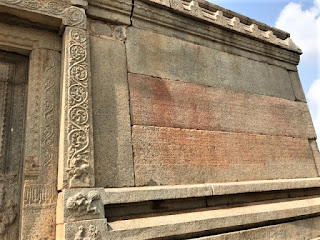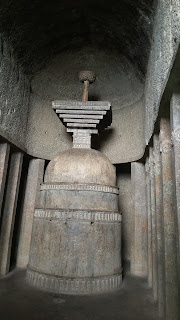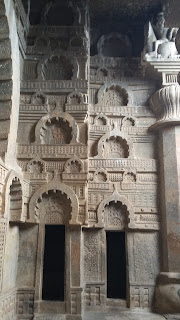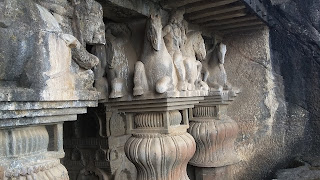The
Vijayanagar bazaar in the Krishnadevaraya’s times (around 1500 AD) was the
second largest bazaar in the world, second only to the Egyptian bazaar,
flaunted my local guide at the Vijaya Vitthala Temple, Hampi. While the veracity of this is moot what with the Egyptian highs related to the 3000-50 BC
while Vijayanagar was centuries later, let’s not belittle his pride, for it is
really becoming of the place!
 |
| Entrance gopuram to Vijaya Vitthala Main Temple |
 |
| The pillars of the Hampi Bazaar leading up to the temple |
The Vijaya
Vitthala Complex, Hampi, and its famous bazaar whose operations are recorded
meticulously in the inscriptions on the Temple and mantapas indicate an
admirable cache of wealth, power, and yet the humility and largesse of its
rulers. The ‘King’s Balance’ in the Vijaya Vitthala Complex where the king
would weigh himself and give away the equivalent in gifts and rewards, is
explicit of their famed benevolence.
 |
| The King's Balance- Hooks on top, and the inscription of the pious King and the Queens beneath it. |
The large
L-shaped pillared markets leading far out from the temple front exemplify the
rich, thriving economy of those days. Their pride in success is evident as
its activities are meticulously recorded on the wall carvings of the temple. Symbols
of people of different ethnicities and countries bartering elephants, horses in
exchange for jewels and riches in these markets, indicate a peaceful, multi-cultural
society, known for its fame and was frequented by foreign travellers. “They are
checking and counting the horse’s teeth before bartering it” pointed out my
guide. He was an ASI-certified guide and his prowess further certified by my
friendly and sporting local autowalla!
The Vijaya
Vitthala temple complex is an exhaustive one, complete with all the
facilities- public and royal baths, platforms for entertainment, markets for
trade, resting and eating places, and places of worship and the main deity was
Vitthala. The meaning of “Vitthala” as explained by singer Aruna Sairam when
delivering a Marathi composition, stands for “Vitth” which is a brick and
“Sthala” as in “a place or location”. It is said that when Krishna as
Panduranga came to check in on the famed Pundalika for his loyalty and undivided
service to his aged, invalid parents, Pundalika replied saying that he was busy
and would come and meet him after he was done. Pundalika threw a brick and
asked the guest to stand on it and wait. Thus, the name “Vitthala” to exemplify
Krishna, a deity who commanded undivided faith and prayers.
The main
parts to watch out for when you visit the complex include the Gejjala (Salangai
or ghunghroo) Mantapa, Kaduregombe Mantapa, and a public bath opposite it. The
Pushkarani or the royal bath with a mantapa for prayers, a long walkway with
the famed bazaar on the right leading up to the main temple. A covered hall to
the left of the main temple that is being meticulously restored for its fallen pillars,
the main sanctum.
The main temple is itself large and intriguing, with the main
gopuram (entrance structure atop the entryway), a Bhajana mantapa, a Tulsi mantapa,
Deepa Sthambam and Homa kundam. The main idol of the sanctum is lost. The Musical Pillars is an engineering feat of those days that left me embarrassed of our flyovers with faults in the joints in sections and water dripping and scarring the road beneath it. The guide certifies that the pillars are not hollow; just the minute, carefully-engineered differences in their thicknesses and position of elements on the pillars that generate music, which can be heard afar when played.
 |
| The Musical Pillars, Vijaya Vitthala Temple, Hampi |
 |
| The Ratha |
 |
| Remains of original colours on the Ratha |
Back and
out of the main temple, as you go clockwise around it, is the King’s Balance, a
Vishnu temple behind with inscriptions in old Kannada, a gopuram over the exit
to the right of the main sanctum, the famous stone chariot (a monolith Ratha),
and a temple far-removed from the main temple and to your left as you complete
the outer round of the main sanctum. This sanctum (Sannadhi) is curiously
guarded by an Indian one side and a Mongol on the other side! It carries a rich
cache of carvings of horse-drawn chariots, wars and such. The numbered bricks
in this hall and the sanctum indicate a meticulous restoration. Intriguingly,
the hall is outstanding for its angular approach pillars!
The entire
complex is a long walk with items of interest all around. It’s best to walk up
and around while going in and using the battery car service to drop you at the
entrance on your way out. It’s best to hire a guide to point out the main
structures and the details of the ratha, though they usually pepper it with
their imagination! And a good 2-5 hours to see and relish the complex,
depending upon the depth of your interest from a casual one to a sheer,
mouth-aghast one leading you to devour the details in its entirety. I visited
it a second time as I didn’t want to miss out anything!
 |
| The Vishnu temple with inscriptions in old Kannada, Behind the main temple, Vijaya VItthala Complex |
There is an
entrance fee for this complex that allows entry into the Kamalapur Archaeological
Museum and the Zenana enclosure. The Museum leaves a lot of gaps in information
for a museum enthusiast.
A local, well-informed
auto guy and my buddy who effortlessly planned my itinerary for all the five
days of my stay, if you are interested, is Ganesh 94820 53289.









